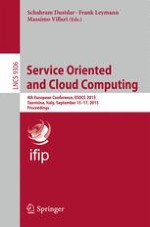2015 | Book
Service Oriented and Cloud Computing
4th European Conference, ESOCC 2015, Taormina, Italy, September 15-17, 2015, Proceedings
Editors: Schahram Dustdar, Frank Leymann, Massimo Villari
Publisher: Springer International Publishing
Book Series : Lecture Notes in Computer Science
